Chanyoung Kim
Spatial Transport Optimization by Repositioning Attention Map for Training-Free Text-to-Image Synthesis
Mar 28, 2025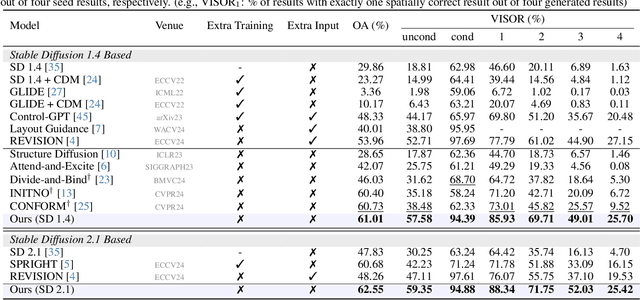
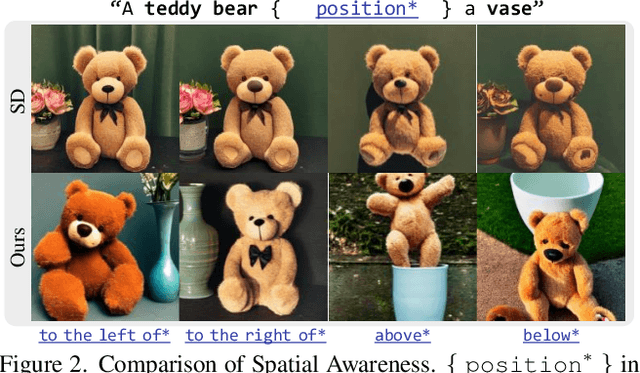
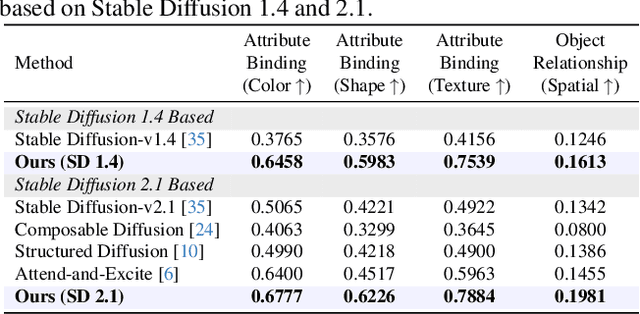
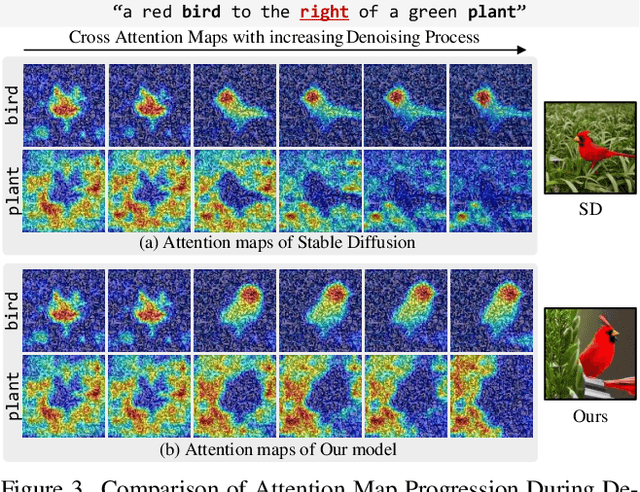
Abstract:Diffusion-based text-to-image (T2I) models have recently excelled in high-quality image generation, particularly in a training-free manner, enabling cost-effective adaptability and generalization across diverse tasks. However, while the existing methods have been continuously focusing on several challenges, such as "missing objects" and "mismatched attributes," another critical issue of "mislocated objects" remains where generated spatial positions fail to align with text prompts. Surprisingly, ensuring such seemingly basic functionality remains challenging in popular T2I models due to the inherent difficulty of imposing explicit spatial guidance via text forms. To address this, we propose STORM (Spatial Transport Optimization by Repositioning Attention Map), a novel training-free approach for spatially coherent T2I synthesis. STORM employs Spatial Transport Optimization (STO), rooted in optimal transport theory, to dynamically adjust object attention maps for precise spatial adherence, supported by a Spatial Transport (ST) Cost function that enhances spatial understanding. Our analysis shows that integrating spatial awareness is most effective in the early denoising stages, while later phases refine details. Extensive experiments demonstrate that STORM surpasses existing methods, effectively mitigating mislocated objects while improving missing and mismatched attributes, setting a new benchmark for spatial alignment in T2I synthesis.
Fourier Decomposition for Explicit Representation of 3D Point Cloud Attributes
Mar 13, 2025Abstract:While 3D point clouds are widely utilized across various vision applications, their irregular and sparse nature make them challenging to handle. In response, numerous encoding approaches have been proposed to capture the rich semantic information of point clouds. Yet, a critical limitation persists: a lack of consideration for colored point clouds which are more capable 3D representations as they contain diverse attributes: color and geometry. While existing methods handle these attributes separately on a per-point basis, this leads to a limited receptive field and restricted ability to capture relationships across multiple points. To address this, we pioneer a point cloud encoding methodology that leverages 3D Fourier decomposition to disentangle color and geometric features while extending the receptive field through spectral-domain operations. Our analysis confirms that this encoding approach effectively separates feature components, where the amplitude uniquely captures color attributes and the phase encodes geometric structure, thereby enabling independent learning and utilization of both attributes. Furthermore, the spectral-domain properties of these components naturally aggregate local features while considering multiple points' information. We validate our point cloud encoding approach on point cloud classification and style transfer tasks, achieving state-of-the-art results on the DensePoint dataset with improvements via a proposed amplitude-based data augmentation strategy.
Pathology-Aware Adaptive Watermarking for Text-Driven Medical Image Synthesis
Mar 11, 2025Abstract:As recent text-conditioned diffusion models have enabled the generation of high-quality images, concerns over their potential misuse have also grown. This issue is critical in the medical domain, where text-conditioned generated medical images could enable insurance fraud or falsified records, highlighting the urgent need for reliable safeguards against unethical use. While watermarking techniques have emerged as a promising solution in general image domains, their direct application to medical imaging presents significant challenges. A key challenge is preserving fine-grained disease manifestations, as even minor distortions from a watermark may lead to clinical misinterpretation, which compromises diagnostic integrity. To overcome this gap, we present MedSign, a deep learning-based watermarking framework specifically designed for text-to-medical image synthesis, which preserves pathologically significant regions by adaptively adjusting watermark strength. Specifically, we generate a pathology localization map using cross-attention between medical text tokens and the diffusion denoising network, aggregating token-wise attention across layers, heads, and time steps. Leveraging this map, we optimize the LDM decoder to incorporate watermarking during image synthesis, ensuring cohesive integration while minimizing interference in diagnostically critical regions. Experimental results show that our MedSign preserves diagnostic integrity while ensuring watermark robustness, achieving state-of-the-art performance in image quality and detection accuracy on MIMIC-CXR and OIA-ODIR datasets.
Distilling Spectral Graph for Object-Context Aware Open-Vocabulary Semantic Segmentation
Nov 26, 2024Abstract:Open-Vocabulary Semantic Segmentation (OVSS) has advanced with recent vision-language models (VLMs), enabling segmentation beyond predefined categories through various learning schemes. Notably, training-free methods offer scalable, easily deployable solutions for handling unseen data, a key goal of OVSS. Yet, a critical issue persists: lack of object-level context consideration when segmenting complex objects in the challenging environment of OVSS based on arbitrary query prompts. This oversight limits models' ability to group semantically consistent elements within object and map them precisely to user-defined arbitrary classes. In this work, we introduce a novel approach that overcomes this limitation by incorporating object-level contextual knowledge within images. Specifically, our model enhances intra-object consistency by distilling spectral-driven features from vision foundation models into the attention mechanism of the visual encoder, enabling semantically coherent components to form a single object mask. Additionally, we refine the text embeddings with zero-shot object presence likelihood to ensure accurate alignment with the specific objects represented in the images. By leveraging object-level contextual knowledge, our proposed approach achieves state-of-the-art performance with strong generalizability across diverse datasets.
ESG Classification by Implicit Rule Learning via GPT-4
Mar 22, 2024Abstract:Environmental, social, and governance (ESG) factors are widely adopted as higher investment return indicators. Accordingly, ongoing efforts are being made to automate ESG evaluation with language models to extract signals from massive web text easily. However, recent approaches suffer from a lack of training data, as rating agencies keep their evaluation metrics confidential. This paper investigates whether state-of-the-art language models like GPT-4 can be guided to align with unknown ESG evaluation criteria through strategies such as prompting, chain-of-thought reasoning, and dynamic in-context learning. We demonstrate the efficacy of these approaches by ranking 2nd in the Shared-Task ML-ESG-3 Impact Type track for Korean without updating the model on the provided training data. We also explore how adjusting prompts impacts the ability of language models to address financial tasks leveraging smaller models with openly available weights. We observe longer general pre-training to correlate with enhanced performance in financial downstream tasks. Our findings showcase the potential of language models to navigate complex, subjective evaluation guidelines despite lacking explicit training examples, revealing opportunities for training-free solutions for financial downstream tasks.
Advancing Text-Driven Chest X-Ray Generation with Policy-Based Reinforcement Learning
Mar 11, 2024



Abstract:Recent advances in text-conditioned image generation diffusion models have begun paving the way for new opportunities in modern medical domain, in particular, generating Chest X-rays (CXRs) from diagnostic reports. Nonetheless, to further drive the diffusion models to generate CXRs that faithfully reflect the complexity and diversity of real data, it has become evident that a nontrivial learning approach is needed. In light of this, we propose CXRL, a framework motivated by the potential of reinforcement learning (RL). Specifically, we integrate a policy gradient RL approach with well-designed multiple distinctive CXR-domain specific reward models. This approach guides the diffusion denoising trajectory, achieving precise CXR posture and pathological details. Here, considering the complex medical image environment, we present "RL with Comparative Feedback" (RLCF) for the reward mechanism, a human-like comparative evaluation that is known to be more effective and reliable in complex scenarios compared to direct evaluation. Our CXRL framework includes jointly optimizing learnable adaptive condition embeddings (ACE) and the image generator, enabling the model to produce more accurate and higher perceptual CXR quality. Our extensive evaluation of the MIMIC-CXR-JPG dataset demonstrates the effectiveness of our RL-based tuning approach. Consequently, our CXRL generates pathologically realistic CXRs, establishing a new standard for generating CXRs with high fidelity to real-world clinical scenarios.
EAGLE: Eigen Aggregation Learning for Object-Centric Unsupervised Semantic Segmentation
Mar 03, 2024



Abstract:Semantic segmentation has innately relied on extensive pixel-level labeled annotated data, leading to the emergence of unsupervised methodologies. Among them, leveraging self-supervised Vision Transformers for unsupervised semantic segmentation (USS) has been making steady progress with expressive deep features. Yet, for semantically segmenting images with complex objects, a predominant challenge remains: the lack of explicit object-level semantic encoding in patch-level features. This technical limitation often leads to inadequate segmentation of complex objects with diverse structures. To address this gap, we present a novel approach, EAGLE, which emphasizes object-centric representation learning for unsupervised semantic segmentation. Specifically, we introduce EiCue, a spectral technique providing semantic and structural cues through an eigenbasis derived from the semantic similarity matrix of deep image features and color affinity from an image. Further, by incorporating our object-centric contrastive loss with EiCue, we guide our model to learn object-level representations with intra- and inter-image object-feature consistency, thereby enhancing semantic accuracy. Extensive experiments on COCO-Stuff, Cityscapes, and Potsdam-3 datasets demonstrate the state-of-the-art USS results of EAGLE with accurate and consistent semantic segmentation across complex scenes.
LISA: Localized Image Stylization with Audio via Implicit Neural Representation
Nov 21, 2022

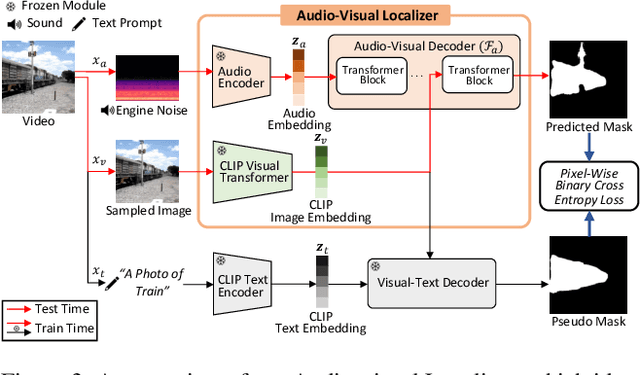

Abstract:We present a novel framework, Localized Image Stylization with Audio (LISA) which performs audio-driven localized image stylization. Sound often provides information about the specific context of the scene and is closely related to a certain part of the scene or object. However, existing image stylization works have focused on stylizing the entire image using an image or text input. Stylizing a particular part of the image based on audio input is natural but challenging. In this work, we propose a framework that a user provides an audio input to localize the sound source in the input image and another for locally stylizing the target object or scene. LISA first produces a delicate localization map with an audio-visual localization network by leveraging CLIP embedding space. We then utilize implicit neural representation (INR) along with the predicted localization map to stylize the target object or scene based on sound information. The proposed INR can manipulate the localized pixel values to be semantically consistent with the provided audio input. Through a series of experiments, we show that the proposed framework outperforms the other audio-guided stylization methods. Moreover, LISA constructs concise localization maps and naturally manipulates the target object or scene in accordance with the given audio input.
Robust Sound-Guided Image Manipulation
Aug 31, 2022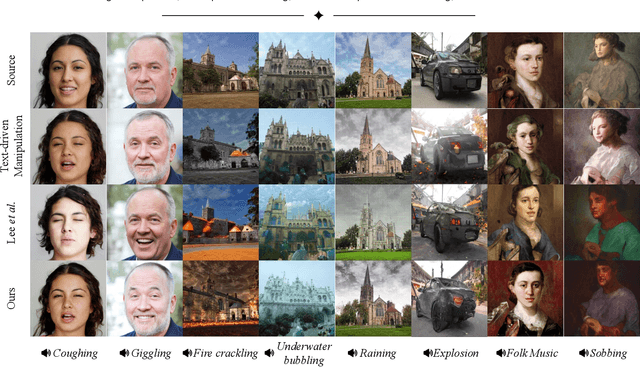
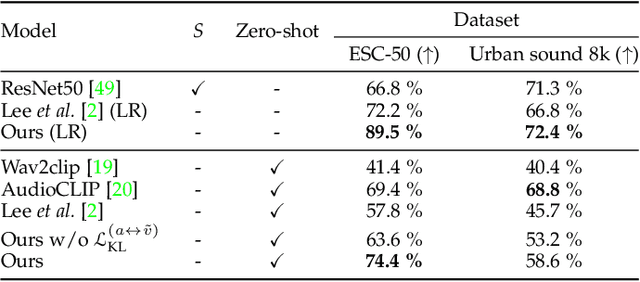


Abstract:Recent successes suggest that an image can be manipulated by a text prompt, e.g., a landscape scene on a sunny day is manipulated into the same scene on a rainy day driven by a text input "raining". These approaches often utilize a StyleCLIP-based image generator, which leverages multi-modal (text and image) embedding space. However, we observe that such text inputs are often bottlenecked in providing and synthesizing rich semantic cues, e.g., differentiating heavy rain from rain with thunderstorms. To address this issue, we advocate leveraging an additional modality, sound, which has notable advantages in image manipulation as it can convey more diverse semantic cues (vivid emotions or dynamic expressions of the natural world) than texts. In this paper, we propose a novel approach that first extends the image-text joint embedding space with sound and applies a direct latent optimization method to manipulate a given image based on audio input, e.g., the sound of rain. Our extensive experiments show that our sound-guided image manipulation approach produces semantically and visually more plausible manipulation results than the state-of-the-art text and sound-guided image manipulation methods, which are further confirmed by our human evaluations. Our downstream task evaluations also show that our learned image-text-sound joint embedding space effectively encodes sound inputs.
ORA3D: Overlap Region Aware Multi-view 3D Object Detection
Jul 02, 2022



Abstract:In multi-view 3D object detection tasks, disparity supervision over overlapping image regions substantially improves the overall detection performance. However, current multi-view 3D object detection methods often fail to detect objects in the overlap region properly, and the network's understanding of the scene is often limited to that of a monocular detection network. To mitigate this issue, we advocate for applying the traditional stereo disparity estimation method to obtain reliable disparity information for the overlap region. Given the disparity estimates as a supervision, we propose to regularize the network to fully utilize the geometric potential of binocular images, and improve the overall detection accuracy. Moreover, we propose to use an adversarial overlap region discriminator, which is trained to minimize the representational gap between non-overlap regions and overlapping regions where objects are often largely occluded or suffer from deformation due to camera distortion, causing a domain shift. We demonstrate the effectiveness of the proposed method with the large-scale multi-view 3D object detection benchmark, called nuScenes. Our experiment shows that our proposed method outperforms the current state-of-the-art methods.
 Add to Chrome
Add to Chrome Add to Firefox
Add to Firefox Add to Edge
Add to Edge